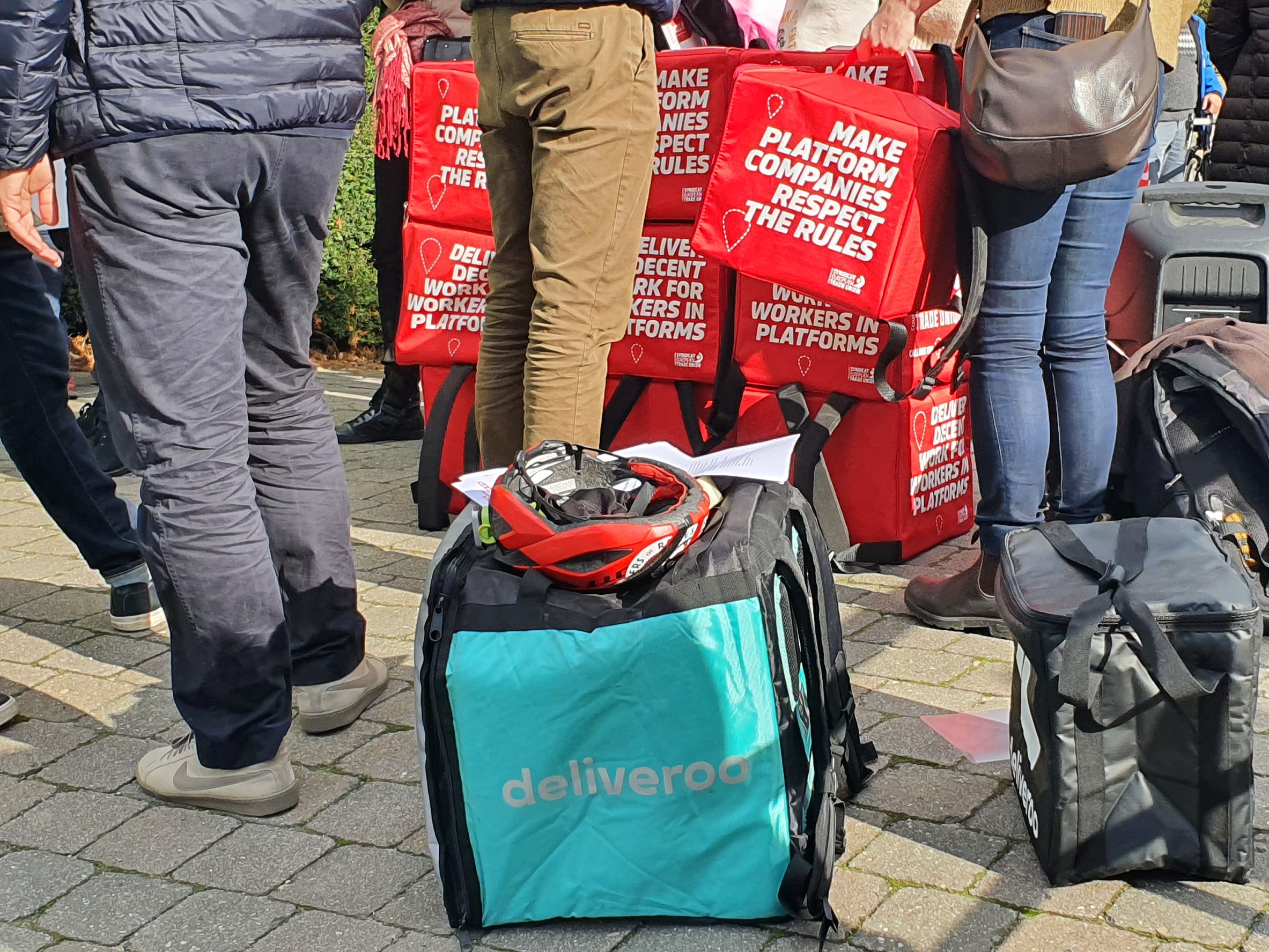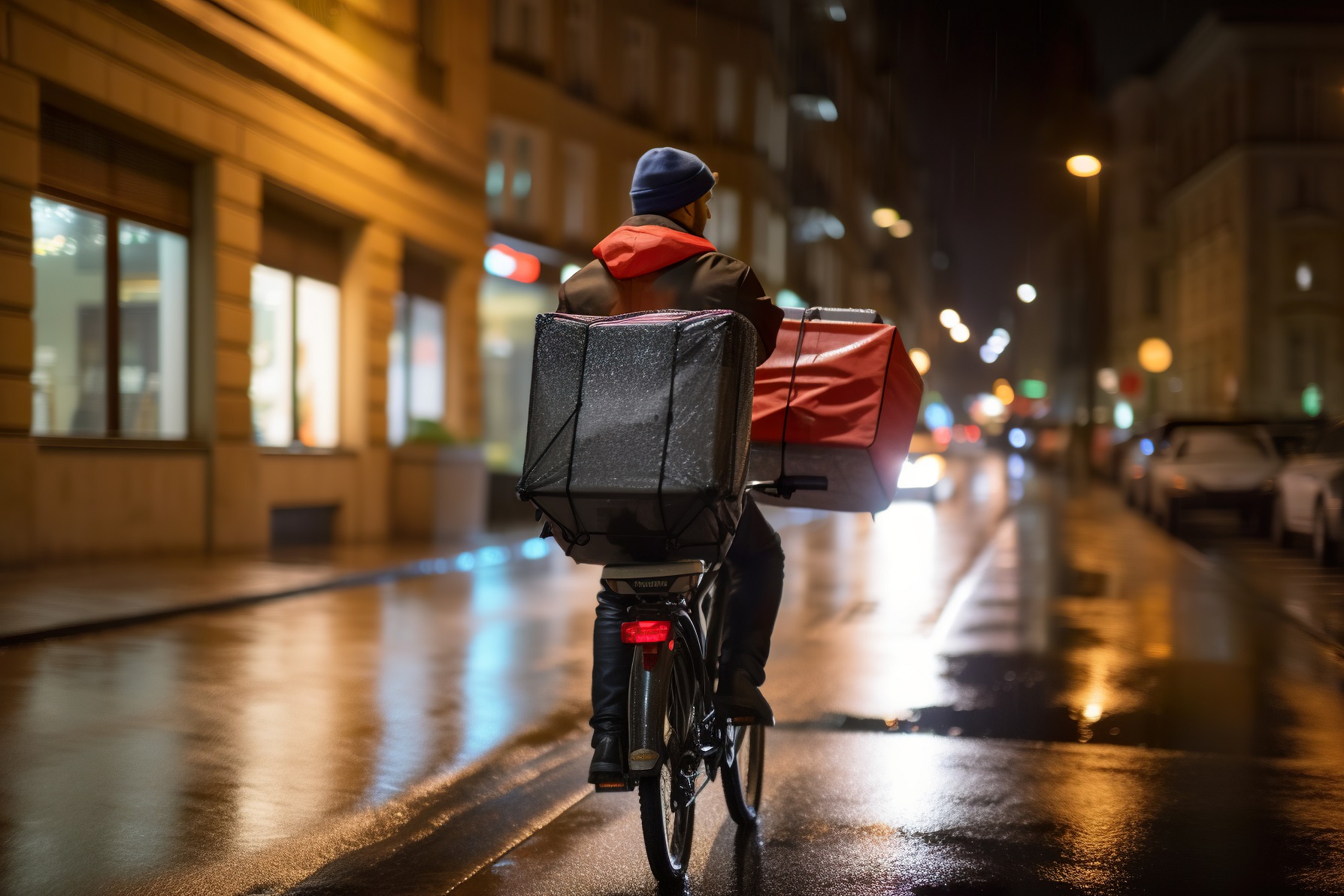It's already dark in this quiet part of Brussels as the heavy rain starts to fall, keeping everyone at home. Everyone, that is, apart from those working to feed us – and those bikers braving the harsh elements to deliver our food. Welcome to today's world of food delivery, a world of customer convenience where meals are brought ready-made to our doorstep.
Since the pandemic lockdowns, food delivery has soared - and many young people have used it as a way to make cash. At €5 on average per delivery plus tips, riders must be quick and efficient, so many of them use shared electric bikes from the likes of Swapfiets, Billy, Voi and Lime. In recent years, they have become part of the urban landscape while ordering takeaway food from Deliveroo, Uber Eats or Takeaway.com has become as common as getting our daily bread at the baker's.
"It's the reality and we have to integrate and accompany all current developments in the food sector, as long as the rules are proportional and equal for everyone, i.e. as long as competition is fair," says Hubert de Bellefroid, Vice President of Brussels HoReCa Federation, which represents the hospitality sector, including restaurants, bars, cafés and hotels. "If there is a demand for takeaway food, why not respond to it?"
So what kind of food are we talking about?
According to Uber Eats, the most popular food delivered by the platform are: 1. Pizza 2. American 3. Asian, and the most ordered item is a burger. "Some food is more adapted to delivery than others," de Bellefroid says.
During the lockdowns, restaurants like Racines, one of the top Italian establishments in Brussels, cooked special menus to be taken away. Their dishes had to be completely rethought to allow for transport and heating at their customers' homes while keeping their taste and premium quality. This tour de force was the price to pay for their survival through the hard times. But as soon as the lockdowns were over, Racines returned to its traditional cuisine to be eaten on-site.
The business model is indeed the main reason why some restaurants still resist partnering with them. For example, Uber Eats pays back 70% of the price of the food ordered from the restaurants (75% if they work exclusively with them) and adds €5 on top of the customer's invoice to pay for the delivery.

Uber Eats delivery rider
Some cannot accept it, including de Bellefroid, who is also Managing Director at The Lodge restaurant in Watermael-Boitsfort. "The commission is too high, so we decided to pull out," he says, adding that when restaurants have problems of financial viability, this doesn't help to restore it.
Restaurants enrol
Award-winning fritkot Master Frites initially refused to enrol with Uber Eats. "We tried by ourselves for a year, with our own app, but you need to put in place a whole infrastructure, with delivery staff, etc.," says co-owner Alban Sefa.
Then it became impossible not to take part in this "soaring trend which everybody praised," he says, so they signed up five years ago. "Dropping 30% of each commission on orders is huge," he says, so they found a way to compensate for a shrinking margin by slightly raising their takeaway price through delivery platforms.
Today, Master Frites hails its partnership with Uber Eats: "We increased our turnover by 30% since we started to work with the platform," Sefa says.
They have on average 60 orders a day on weekdays and up to 100 during the weekend, mostly in the evenings. Their biggest days are Fridays and Sundays. Deliveries represent 40-50% of their turnover. "Uber Eats grants a monthly medal 'The best of Uber Eats' to the restaurants which respect a series of quality criteria. We have had it for three years consecutively," Sefa says.
But the demands are harsh: less than 2% of orders can be missed, and there can be no more than 1% of mistakes in the orders, at least a 4.6/5 average on evaluations and at least 40 orders.
Sefa says they invested heavily to keep up quality standards, buying a dedicated frying appliance with dedicated staff only for Uber Eats orders. They are also using technology to improve efficiency: they can see on their tablet which courier will come to pick up their order and they wait until he's at the door to start cooking ("It takes five minutes") to have the freshest food delivered. "They know us, 90% of couriers who come to us are always the same," he says with a wink.
But not everyone is so pleased with the results. Other restaurants say that they cannot cope with just 70% of the receipts. "It eats up our margins. Many restaurants give up because they cannot follow up," says Maxime, a restaurant owner who asked to remain anonymous. "Do the customers know that 30% of what they pay doesn't go to the restaurant? They don't think of the financial consequences when ordering food online. The customer is like a Pacha, ordering his food from a sofa and getting it delivered by people working in terrible conditions from a restaurant which pulls its pants off."
Maxime points to "the lack of empathy, which is a symptom of a society in decline," and the change in eating habits for prepared dishes damages the hospitality sector itself (now supermarkets are delivering too, with higher margins than on sales of the foods that go into the dishes).

A protest demonstration organised by workers from delivery, trade, cleaning platforms in Brussels in October 2021
The system also hits customers: when food delivery platforms allow their staff to take a couple of orders at the same time it means they never know when their food is delivered. At the same time, the quality of food consumed overall is plummeting. "Some people find it normal to eat takeaway food. They get used to eating half-cold dishes, they get used to junk food," Maxime says.
The view from the platform
Unsurprisingly, delivery platforms see the changes as positive, responding to customer needs. "The pandemic changed consumer expectations around delivery," says Guillaume Malfait, General Manager of Uber Eats Belgium and Switzerland. "As more and more people rely on on-demand delivery to order from restaurants, we are helping them navigate this change and discover new ways to grow their businesses."
Uber Eats delivery gross bookings more than doubled in 2020 to $58 billion globally and have continued to grow quarter after quarter even post-pandemic. Malfait says that "the enduring appeal and convenience of delivery services have led to sustained growth and attractiveness in the business."
Uber Eats, like other platforms, aims at expanding beyond just food delivery to encompass new markets – such as groceries – "where customers value the ease of having products delivered directly to their doorstep."
Malfait rejects the suggestion that Uber Eats is exploiting the situation and instead sees his platform as a "partner in growth" with restaurants. Their key selling point to restaurants is the opportunity to reach a bigger and newer audience. "Partnering with us means restaurants can tap into a diverse customer base, offering fast and reliable service that supports local businesses in expanding their reach."
Uber Eats operates in 70 countries on six continents, and tailors its approach "to fit local culinary preferences and expanding into emerging sectors like grocery and retail delivery," Malfait says. He sees Uber Eats as "an intermediary platform": it provides a service and logistical support, for which it receives a commission on sales. "This commission system is our primary revenue stream and is integral to our business model."
Delivery platforms can also win over small food outlets like Master Frites that want to extend their customer base. "We combine out-of-home and digital marketing, capitalising on our international brand to attract new customers in cosmopolitan cities such as Brussels," Malfait says. The result is that they are the ones being approached. "Restaurants often initiate contact, and we provide them with market insights, professional photoshoots, and comprehensive training for seamless integration on our platform."
Regulatory concerns
But are these platforms breaking or even bending rules for delivery riders? Schaerbeek municipal counsellor Quentin van den Hove is broadly positive about the impact. "A third of couriers are born outside Belgium and don't speak French well enough to be on the general employment market," he says. "The delivery platforms are an opportunity, a stepping stone towards a first job. If the conditions were so terrible, there wouldn't be any queue to apply. What we see is that the demand for courier jobs is higher than the supply."
Van den Hove is also upbeat about what it means for restaurants, insisting there has been no transfer of customers from on-site to online. "On the contrary, it generated new customers, it's an opportunity for restaurants, not a new competition," he says, recalling a restaurant which got new physical customers from the online orders during the lockdowns.
Nonetheless, at the Brussels HoReCa Federation, de Bellefroid is wary of the new methods. "The competition is not bad in itself, as long as the customers know upfront what's on their plate," he says. But a dark kitchen that only supplies food – often pre-cooked dishes – to its customers is a world away from a restaurant with a genuine customer experience. They are "different professions," he says.
Related News
- Uber Eats riders in Brussels to go on strike for better pay and conditions
- Deliver-no-more? Landmark court ruling could see Deliveroo leave Belgium
- Deliveroo, but laundry: Belgian startup digitalises the washing industry
De Bellefroid says politicians should grant the sector better economic and tax conditions and lists four measures that would help: more transparency for all establishments; lower VAT on non-alcoholic drinks to align with supermarkets; higher untaxed overtime possibility; and the indexation of social charges deduction for employers. "Four easy quick wins to support our sector at low public cost," he says.
However, he is doubtful that these measures will be adopted any time soon, not least because Belgium's legislative process is so slow. "The most beautiful profession in the world is becoming more and more difficult to sustain," de Bellefroid says. "We are at the heart of social links in a city, with our restaurants and bars. We are what makes Brussels live. Don't wait too long to realise that Brussels is switching off gradually!"
De Bellefroid also points out the many initiatives taken by his sector to make eating out more attractive: food courts such as Wolf in the city centre or Fox at the former Royale Belge building in Auderghem where customers can enjoy many different cuisines in the same venue. Other developments include one-stop evenings where you can eat, drink and dance at the same place and restaurants coupled with bookshops.
"We want people to go out and move," de Bellefroid says while acknowledging that food delivery platforms have shaken the Brussels gastronomic landscape. "There will always be a demand for an on-site experience, even if the market evolves. We are innovative, we know how to do things others cannot do."

